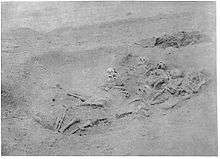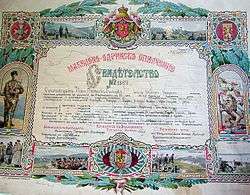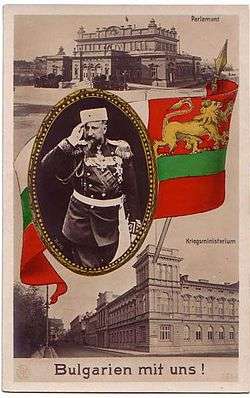Štip massacre
| Štip massacre | |
|---|---|
| Part of World War I | |
 Exhumed remains of those killed in the massacre. | |
| Location | Ljuboten, Kingdom of Serbia |
| Date | 26 October 1915 |
| Target | Serbian soldiers |
Attack type | Summary executions |
| Deaths | 118–120 |
| Perpetrators |
11th Bulgarian Division Internal Macedonian Revolutionary Organization |
The Štip massacre was the mass murder of Serbian soldiers by Bulgarian occupational authorities in the village of Ljuboten on 15 October 1915, during World War I. Sick and wounded Serbian soldiers, recuperating at the Štip town hospital, were detained by Bulgarian forces and IMRO militants before being taken into the vicinity of Ljuboten and killed. An estimated 118–120 Serbian soldiers were executed in the massacre.
Background
The 28 June 1914 assassination of Austro-Hungarian heir presumptive Archduke Franz Ferdinand precipitated Austria-Hungary's declaration of war against Serbia. The conflict quickly attracted the involvement of all major European countries, pitting the Central Powers against the Entente coalition and starting World War I.[1][2]
After the entry of the Ottoman Empire into the war on the side of the Central Powers (November 1914), the decisive factor in the Balkans became the attitude of Bulgaria. Bulgaria occupied a strategically important position on the Serbian flank and its intervention on either side of the belligerents would be decisive. Bulgaria and Serbia had fought each continuously in the previous thirty years: following the Serbo-Bulgarian War of 1885 hostilities continued in the form of an undeclared war during the Macedonian Struggle. The area of Old Serbia then belonging to the Ottoman Empire became the arena of the ethnic violence between the ethnic Serb population represented by the Serbian Chetnik Organization and the pro–Bulgarians from the Internal Macedonian Revolutionary Organization (IMRO).[3][4]
In 1913, Serbia defeated Bulgaria in the Second Balkan War and the Bulgarian government and people generally felt that Serbia had stolen land which rightfully belonged to Bulgaria. The preceding waves of tit for tat war crimes committed by both parties, left relations strained. Starting from December 1914, at least 18 articles appeared in Bulgarian newspapers accusing the Serbian army of perpetrating massacres, mass rapes and other crimes towards the pro–Bulgarian populations of Vardar Macedonia. At the same time IMRO stepped up its attacks in Serbian controlled territories.[5]
While the Allies could only offer Bulgaria small territorial concessions from Serbia and neutral Greece, the Central Powers' promises appeared far more enticing, as they offered to cede most of the land which Bulgaria claimed. With the Allied defeats at the Battle of Gallipoli (April 1915 to January 1916) and the Russian defeat at Gorlice-Tarnów (May to September 1915) demonstrating the Central Powers' strength, King Ferdinand signed a treaty with Germany. On September 21, 1915 Bulgaria began mobilizing for war.[6]
After the victory of the Serbian army in the Battle of Kolubara in December 1914, the Serbian front saw a lull until the early autumn of 1915. Under the command of Field Marshal August von Mackensen, the Austro-Hungarian Balkan Army, the German 11th Army and river flotillas on the Danube and the Sava began an offensive on 6 October 1915, the largest offensive against Serbia. By September 1915, despite the extreme sacrifice of the Serbian army, the Austro-Hungarian Balkan Army, having crossed the rivers Sava and Drina and the German 11th Army after crossing the Danube, occupied Belgrade, Smederevo, Požarevac and Golubac, creating a wide bridgehead south of the Sava and Danube rivers, and forcing Serbian forces to withdraw to southern Serbia.[7]
Massacre
On 15 October 1915, two Bulgarian armies attacked, overrunning Serbian units, penetrating into the valley of the South Morava river near Vranje up to 22 October 1915. The Bulgarian forces occupied Kumanovo, Štip, and Skopje, and prevented the withdrawal of the Serbian army to the Greek border and Salonika.[7]
Štip was conquered by the 3rd Brigade of the 11th Bulgarian Division commanded Aleksandar Protogerov and the IMRO band of Todor Aleksandrov.[8] Štip and the surrounding area were looted by Bulgarian soldiers who refused to obey orders of requisition.[9] On 26 October, Protogerov ordered the execution of 118–120 wounded and sick Serbian soldiers who at the time were recuperating at the Štip town hospital. Elements of IMRO commanded by Ivan Yanev Burlev and the 11th Bulgarian Division then transported to the outskirts of the Ljuboten village, where they were summarily executed. Similar massacres of Serbian prisoners of war and civilians continued until the end of the war.[10] [8]
Aftermath
The Paris Peace Conference, 1919, separated war crimes into 32 specific classes, forming the basis for the future persecution of war criminals identified in previous national and inter–allied commissions. However the question was subsequently forsaken and the responsibility for the trials fell upon the national courts of the Central Powers. A post war Inter–Allied War Commission investigated allegations leveled against Bulgaria, concluding that Bulgarian occupational authorities in Serbia and Greece had breached every single article of the Hague Conventions of 1899 and 1907. The validity of the Štip massacre was confirmed, its victims were exhumed and the perpetrators were identified. The kingdom of Serbia presented a list of 500 Bulgarians it suspected of war crimes, based on the commission's findings. Bulgaria's official response to the enquiry stated that 3 people were arrested and 2 executed for their involvement in various violations of the rules of war. This was later proved to be false, none of the accused were ever convicted of their crimes.[11]
Gallery
 Remains exhumed in Ljuboten
Remains exhumed in Ljuboten Remains exhumed in Ljuboten
Remains exhumed in Ljuboten Remains exhumed in Ljuboten
Remains exhumed in Ljuboten Remains exhumed in Ljuboten
Remains exhumed in Ljuboten Remains exhumed in Ljuboten
Remains exhumed in Ljuboten
See also
Notes
- ↑ Albertini 1953, p. 36.
- ↑ Fischer 1967, p. 73.
- ↑ Christopoulos & Bastias 1977, pp. 215–54.
- ↑ Willmott 2003, pp. 11–15.
- ↑ Pissari 2013, pp. 366–72.
- ↑ Falls 1933, pp. 1–22.
- 1 2 Falls 1933, pp. 22–39.
- 1 2 Pissari 2013, pp. 373–374.
- ↑ Reiss 1919, p. 102.
- ↑ Report of the International Commission 1919, pp. 57–62.
- ↑ Pissari 2013, pp. 363–364.
References
- Albertini, Luigi (1953). Origins of the War of 1914. II. Oxford: Oxford University Press. OCLC 168712.
- Christopoulos, Georgios; Bastias, Ioannis (1977). Ιστορία του Ελληνικού Εθνους: Νεώτερος Ελληνισμός απο το 1881 ως 1913 [History of the Greek Nation: Modern Greece from 1881 until 1913] (in Greek). XIV. Athens: Ekdotiki Athinon.
- Falls, C. (1996) [1933]. Military Operations Macedonia: From the Outbreak of War to the Spring of 1917. History of the Great War Based on Official Documents by Direction of the Historical Section of the Committee of Imperial Defence. I (Imperial War Museum and Battery Press ed.). London: HMSO. ISBN 0-89839-242-X.
- Fischer, Fritz (1967). Germany’s Aims in the First World War. New York: W. W. Norton. ISBN 978-0-393-09798-6.
- Pissari, Milovan (2013). "Bulgarian Crimes against Civilians in Occupied Serbia during the First World War" (PDF). Balcanica. Institute for Balkan Studies (44): 357–390. doi:10.2298/BALC1344357P. Retrieved 8 May 2016.
- Reiss, Rodolphe Archobald (1919). Kingdom of Serbia; Infringements of the Rules & Laws of War Committed by the Austro-Bulgaro-Germans. London: George Allen and Unwen. OCLC 557487215. Retrieved 13 April 2016.
- Report of the International Commission (1919). Album des crimes bulgares : annexes aux documents relatifs aux violations des conventions de la Haye et du droit international en général, commises de 1915-1918 par les bulgares en Serbie occupée. Paris: Yougoslavia. OCLC 17091124.
- Willmott, H. P. (2003). World War I. New York: Dorling Kindersley. ISBN 0-7894-9627-5. OCLC 52541937.

